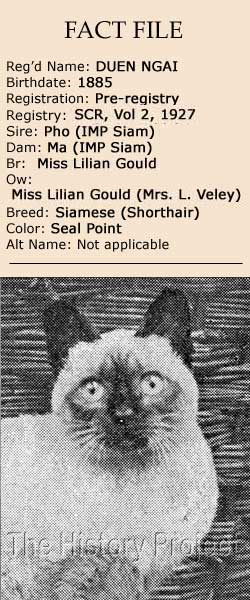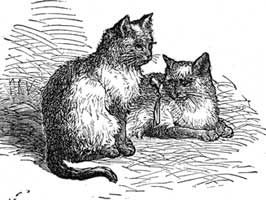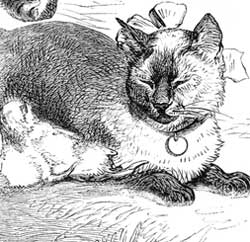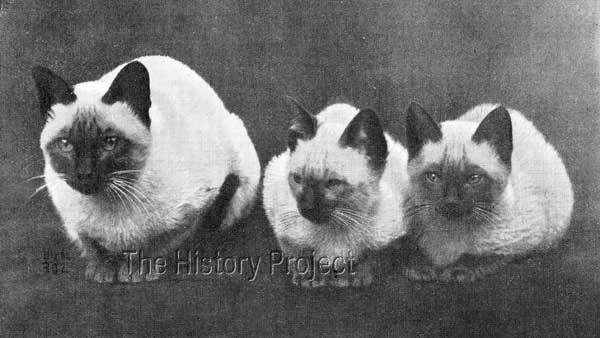 | ||||||||||||||||









|
DUEN NGAI (1885)
|
|||||||||||||||
 |
|
|
HISTORICAL BACKGROUND:
For many decades the story of the arrival of the Gould's 'Pho' and 'Mia' was widely accepted as representative of the foundation of the Siamese breed in Great Britain. But today, we now know that their story was but one of a number of similar importations which occurred between the 1860's and the mid 1880's. These included the almost concurrent importation of 'Susan' and 'Samuel' by Miss Forestier Walker and her sister Mrs. Vyvyan, as well as the many earlier importations of Siamese cats owned by such notables as Lady Dorothy Nevill and the Duke of Wellington, but also Mr. J. Walter, Mr. Brennand and Mrs. Cunliffee Lee. Later there would be even more imports, such as those to Mr. Elliott Hill in Ireland, and then to Lady Marcus Beresford at Bishopsgate and to Mrs. McLaren Morrison in northern Yorkshire.
It is important to always view this history in its original context. Britain was in the heyday of its imperial conquests, with its political and social tentacles extending into Egypt and Abyssinia, into China, India, Burma and in various other parts of South East Asia, from where many of these imports were being sourced.
In all of these places, there were a plethora of diplomatic and military appointments, with familial links back to the domestic population in the 'motherland' and very naturally, many fascinating material objects and animals were caught up in a burgeoning trade of curiosities! And this of course, included cats!
It is, therefore, not at all surprising that many importations went unrecorded and/or unnoticed by historians and how information regarding them is gleaned often only by delving into private correspondence or memoirs, or into small long forgotten published articles still extant from the period.
But the story of the importation of 'Pho' and 'Mia' is none-the-less an important one, as it illustrates the difficulty and dangers associated with organising the shipping of livestock over such long distances, and then, once having obtained the prize, being able to care for and protect the very rare and valuable investment with which you have been entrusted.
In a dissertation on the early Siamese, in Volume 2 of the Siamese Cat Register, Mrs. Veley (formerly Miss Lilian Gould), claims to have been the first to exhibit Siamese cats in that country, at the Crystal Palace in 1885.4 However, she was clearly not the first, that honour having fallen to Mr. Maxwell, who is recorded in the press to have been the owner of Siamese kittens exhibited at the first Crystal Palace Show in July, 1871. Lady Dorothy Nevill, also exhibited Siamese, most likely at the second Crystal Palace Show in December, 1871 and also probably at the May Show of 1872, while Mr. J. Walter is on record for having exhibited his Siamese queen, 'Mymie', born 1870, with a litter of young kittens at the Crystal Palace in 1875.6
Mrs. Veley's report however on the importation of 'Pho' and 'Mia' may be relied upon, and these are probably the first verifiable imports of Siamese for which there is a traceable history, involving as it did, both of Miss Gould's brothers; firstly Mr. E.B. Gould, who was for many years Her Majesty's Consul at Bangkok, and then her other brother, Mr. Owen Gould, who was instrumental in bringing both 'Pho' and 'Mia' into England from Bangkok, in 1884.
 |
 |
|
Above right: Mr. J. Walters 'Mymie' with nursing kittens, exhibited at the Crystal Palace Cat Show of 18756 Below: Two Siamese kittens exhibited by Mrs. Cunliffe Lee, at the Crystal Palace Cat Show of 1879.7 Image set courtesy of The Harrison Weir Collection |
|
 |
|
PARENTAGE & OWNERSHIP:
Unknown
Pho (IMP Siam)
| Unknown
Duen Ngai, 1885, Seal Point Siamese, M
| Unknown
Ma (IMP Siam)
Unknown
'Duen Ngai' is recorded in Volume 2 of the Siamese Cat Register (1927) as entry No. (3a). His date of birth is listed as March, 1885, so from this we know that he was a kitten from the first litter born in England, sired by the imported Siamese male 'Pho', listed as entry (1a), and out of the imported Siamese female 'Mia', listed as entry (2a).4
It is interesting to note that despite this being a significant historical event, it is not recorded by Miss Frances Simpson in the chapter on Siamese in The Book of The Cat (1903) published by Cassell; nor is it mentioned by any of the Siamese breeders or contributors to that chapter.
So it is from Mrs. Veley herself, that we gain an enlightening insight into the background behind the importation of 'Pho' and 'Mia', given in a 'foreward' under her hand, written for Volume 2 of The Siamese Register:
"The earliest cats of which I have any personal knowledge were imported for me in 1884 by my brother, Mr. Owen Gould, and their progeny, exhibited by me at The Crystal Palace 17th Annual Cat Show, in October 1885. From that time to 1890 and onwards a great many Siamese cats passed through my hands as a breeder, including some bred or imported by Mrs. Lee, of Penhurst, Mrs. Hannan, Mrs. Backhouse, and later, Lady O'Malley. Oddly enough I do not remember coming across any of my friend, Mrs. Maturin's, but she must have started breeding very little later than I did....
"Another brother of mine, the late Mr. E.B. Gould, H.M. Consul-General at Bangkok, who built what was, I believe, the first cattery there, bred for years, and about 1889, introduced four cats into Ceylon, where they are now common, and are called "Gould's cats". Dr Charles Jose tells me that they are also plentiful in Borneo now. The cats in Siam never had more than two in a litter; my first imported pair, Pho and Mia, increased that to four, but that was the highest number of kits they reached at a birth."4
This information is most revealing, indicating as it does, that 'Pho' and 'Mia' were only Mrs. Veley's first imported pair, therefore implying that she later imported other pairs, or other Siamese after that date. It also shows, that from her brother the Consul-General, (as a local breeder in Siam), it would have been very possible to obtain further bloodstock. The Consul-General also appears at least, to have been partially responsible for the spread of the breed to a number of locations in and around the east Indian Ocean and possibly into South East Asia and beyond.
Sadly no photographs have appeared of either of 'Duen Ngai's' parents, but we may now wonder, whether perhaps, they continued to be bred from, producing other litters of Siamese kittens which were not recorded or registered but nevertheless added to the growing gene pool of Siamese cats in England. And if they were not the only pair imported by Mrs. Veley, what other cats did she obtain and where are their progeny? If 'Pho' and 'Mia' usually had four kittens in a litter, were there brothers or sisters to 'Duen Ngai' and to whom were they sold?
From an article about Mrs. Veley's kittens from 'Pho' and 'Mia' in Cat Gossip, edited by Mr. H. C. Brooke in 1927, we are told that the name 'Duen Ngai' means 'Moonlight', and that 'Duen Ngai' was so named because Mrs. Veley considered him to be the lightest coated and densest pointed cat she ever saw.1
SIBLINGS & SHOWS:
However, 'Duen Ngai' was not the only progeny of record from 'Pho' and 'Mia', as a repeat breeding produced a second litter born in July, 1885. From this came the male kittens 'Kalahom' (SCR: 4a) and 'Khromata', (SCR: 5a)4
 |
|
Progeny of 'Pho' and 'Mia', Siamese cats imported from Bangkok, by Mr. Owen Gould, in 1884. Photo: Cat Gossip, 28th September, 19271 Image courtesy of The CFA Foundation |
 |
|
All three, by 'Pho' and out of 'Mia' were exhibited at the Crystal Palace Show in 1885. Photo: Henry Dixon & Son. The Siamese Cat Register (Vol.2) 1927, compiled by Major E. Sydney Woodiwiss 4 Image courtesy of The CFA Foundation |
In the excellent photographs above, we first see another view of 'Duen Ngai' together with his younger full sibling 'Kalahom', whom we are informed was duly sold to a Mrs. Bazalgette. In the second photograph, 'Duen Ngai' is accompanied both of his younger siblings. From the same article we also learn that the names of 'Kalahom' and 'Khromata' signify 'Foreign Minister' and 'Minister of Finance' respectively!1
Apparently 'Pho', 'Mia' and all three kittens were exhibited at the Crystal Palace Show in October 1885. Their appearance caused a small sensation, due to their clarity of colour, their friendly personalities and their success as exhibits. The young brothers took a first in their class, but 'Duen Ngai', won two firsts, and a special for Best of Any Variety in Show, and for Best Shorthair Cat in the Show!1
In her book 'The Siamese Cat' Phyllis Lauder gives us her version of the event, quoting a record of it by the then late Cyril Yeates:
"Mr. Owen Gould brought a pair to England in 1884. This is the first known authentic record. In this year, there existed no register, but the cats were written about and discussed in catalogues and journals by the small band of fanciers who saw them when Mr. Gould exhibited them. Their arrival was placed on record by the late Cyril Yeates, for many years chairman of The Governing Council of the Cat Fancy, who tells us, among other things, that they were exhibited at the Crystal Palace in 1885. Their appearance was striking and they were sufficiently different from the western cats to excite a good deal of comment. The unusual coat pattern produced by the restriction of colour to the points, the vivid blue eyes, the deep voice and the great liking of these cats for human companionship caused a sensation. This was the start of the success story which has been recorded step by step."2
BREEDING & PROGENY:
But alas, the triumph was short-lived and a great tragedy was to strike within a week. All three exhibits contracted distemper, and within 7 days all three had succumbed. As their fine portraits will attest, this was a very sad loss to the world of Siamese cats and an unfortunate and very costly reminder that nothing is assured where livestock is concerned, no matter how much care we may think we have taken. For some time after this, many breeders of Siamese shied away from exhibiting for fear of losing their cats, with only the most proven and hardy of Siamese cats making an appearance.
PHOTOS:
 |
|
Photo: by Dixon. From Your Cat: Its Care and Treatment, A. de Bary-Saunders/ex Cat Gossip. Image courtesy of The Harrison Weir Collection |
The above is a remarkable photograph of an equally remarkable cat, and is an image of historical significance. It shows a young cat of approximately seven months of age, in excellent health, with a beautifully clear body colour, with highly desirable contrasting point definition, in a very young exhibit. The appearance is one of vigour and alertness. This image was most likely taken by Dixon at the Crystal Palace Show in 1885. Note that the wicker basket in which the cat was carried is shown as a background. How fortunate we are to have this image of 'Duen Ngai' on the special occasion of his Best Shorthair Cat in Show win, and only seven days before his untimely demise.
SOCIAL MEDIA :
None currently available.
In Summary:
From the story of 'Duen Ngai' his parents and siblings, we see into a complex world of cat fancying across vast distances. We are transported into Siam, into the cattery of Consul-General Gould and his personal passion for Siamese cats, one which was very obviously shared by both his brother, and sister.
Miss Lillian Gould (later Mrs. Veley) went on to be one of the founding members of The Siamese Cat Club in 1901, and was still very active in breeding Siamese, over forty years later, when she wrote the 'foreward' to the second volume of The Siamese Cat Register. The first paragraph of that document begins with:
"The cult of the Siamese cat has made so much advance since the publication of Vol.1 of 'The Siamese Register' in 1924 that we cannot but welcome with enthusiasm the appearance of a second volume of this most useful work, under the capable editorship of Major E.S. Woodiwiss. The membership of the Siamese Cat Club has risen from 75 to 146, showing the increased appreciation by the public of this beautiful breed."
It is still evident from these few words, that the original love she held and nurtured for Siamese since her start with the breed in 1885, remained constant and was clearly apparent, 42 years later when penning this paragraph. Of such is the draw and the appeal of the 'The Siamese Cat'.
REFERENCES:
- Cat Gossip, 28th September, 1927
- The Siamese Cat, by Phyllis Lauder, 1971
- Your Cat: Its Care and Treatment, by A. de Bary-Saunders.
- The Siamese Register, Vol. 1 (1924) and Vol. 2 (1927)
- Every Saturday, (1871)
- The Illustrated Sporting and Dramatic News, October 1875.
- The Illustrated Sporting and Dramatic News, October 1879.
- Photos and quotations as per sources quoted.
Registers associated with this article include The Incorporated Cat Fanciers Association of Great Britain (TICFAGB), National Cat Club (NCC), The Cat Club (CCR), Beresford Cat Club (BCC), Feline Federation Francaise (FFF), Siamese Cat Registry (SCR), US Register & Studbook for Cats (USR)including Supplement(USRS), The Studbook of the American Cat Association (ACA), and the Studbook & Register of the Cat Fanciers' Association (CFA).
Home | Cats | Gallery | Clubs | People | Artifacts | Articles | Updates | Contact Us
©The CFA Foundation, Inc and The Harrison Weir Collection
This project is a collaboration between The CFA Foundation, Inc. and The Harrison Weir Collection.
All material on this site is copyrighted and may not be printed or reproduced, in any form, without the express written consent of the collaborators.